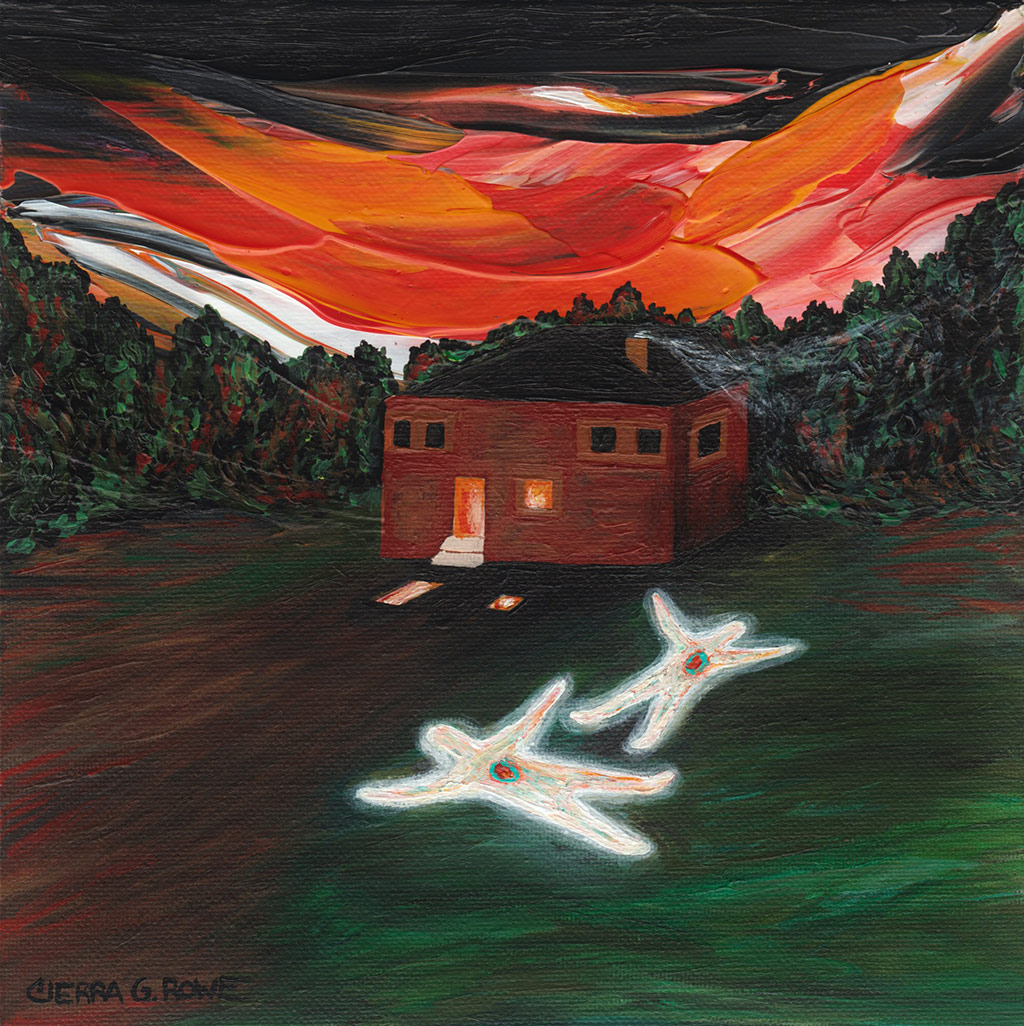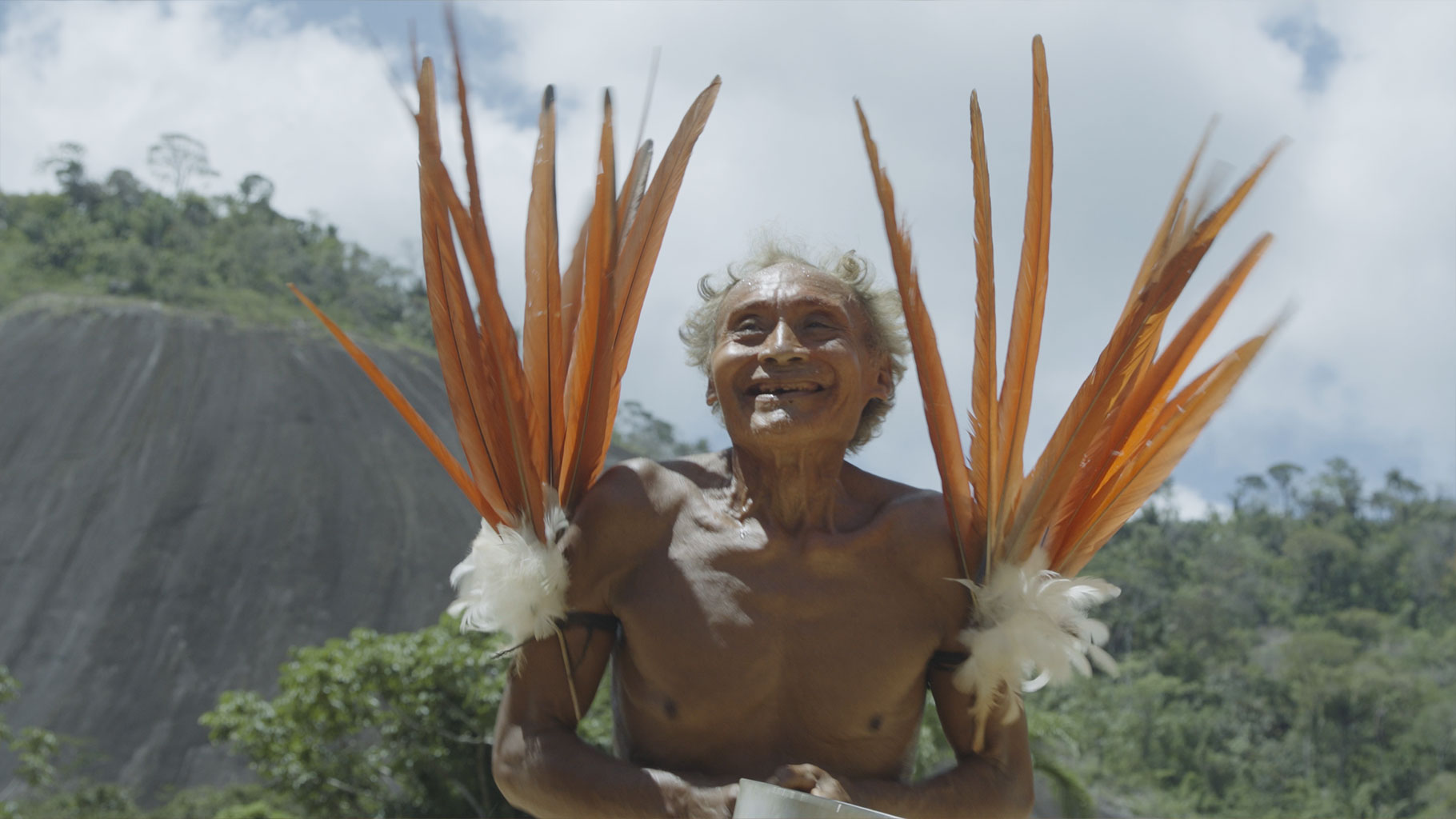
Cabin Fever, 8″ x 8″, acrylic on canvas panel, 2024
Evolution Through Transformative Moments
Central to Rowe’s paintings is her ability to represent the universality of different beings. Self-professed as someone who “can’t stand superficiality,” Rowe avoids paintings of the traditional human form. Instead, she explains, “I try to focus on spirit, energy, nature and all of the complexities [of] a human being that tends to be compromised.”
Her figures are emotive and evocative, yet don’t possess traits that ascribe them to any particular racial group or demographic. They don’t wear recognizable clothes or bear specific cultural markings; they are also rarely placed in settings identifiable as a certain time or place.
“A couple years ago, I lost my grandmother. While we were all in a room with her, she passed away, but we were all surrounding her so that she could pass on in peace. I saw her form,” Rowe recalls. “In that moment, something changed me… I was no longer comfortable with painting… the human form, because I had seen the deterioration of someone that I loved very much.”
Significant life events such as deaths in the family led Rowe to embrace figurative painting differently. Other uncomfortable aspects of her upbringing also informed the approach.
“I went to school with a lot of people who didn’t look like me, and because I didn’t look like them, I was treated very poorly,” she explains. “When you grow up in a town like that… you begin to see things really differently.”
Rowe has evolved significantly since middle school. Still, she admits, “The pain that they caused doesn’t change; it just kind of stays there, kind of stagnant.”
“As a woman — especially as a Black [Native] woman… so much is projected onto you,” she continues. “You’re expected to be sexual and attractive and to awaken the male gaze. And as a Black person… all of these things that don’t even resonate with you: they’re projected onto you.”
In the midst of these experiences, Rowe felt uncomfortable with her identity. She didn’t want to be called a color or even a woman. She found herself limiting her interactions so as to not catch the attention of men; she also grew up very confused about her gender and rather disgusted at being female. Feeling both “humiliated” and like “a walking fetish,” she started wearing baggy clothes to cover her body.
“So, in my paintings, I want to paint something that’s beyond this surface thing where you’re Black, you’re a woman, you’re this or that, you’re pretty attractive or unattractive. I wanted to go beyond that,” she describes, in response to her earlier formative years.
Now, when Rowe looks at her own paintings, she proudly believes that her beings could represent anyone, regardless of their religion, sexual orientation, gender, identity, or background.
“Anybody can look into my paintings, and they can see themselves,” she explains. “They can be included, rather than excluded.”


(Top) Cherry Autumn Mums, 8″ x 10″, acrylic on canvas panel, 2023
(Bottom) Warmer Than Fire, 8″ x 10″, acrylic on canvas panel, 2024
Finding the Inner Light and Inner Glow
Though Rowe’s figures don’t have especially identifiable characteristics, she does find ways to show that the characters are human or perhaps have human-like experiences.
“That’s why I often paint one organ with my paintings, and that’s the heart – because I feel like that’s the center of every human being,” she says.
She likes to think of her characters as “bright shadow beings” and represents them with silhouettes that are filled with color, or sometimes veins, as if to visualize the experience of finding light within dark times. Growing up in a school where she was the only Black kid, Rowe often felt like a shadow.
“Everywhere that I went… I couldn’t blend in; I just stood out in this ocean of fair faces,” she shares. “With these paintings, I try to capture the energy of human beings: all their complexities, their emotions, and their history and feelings, and I try to capture that with color.”
“It’s just the human spirit in the purest form….” she continues. “I think that the purest form of a human spirit is everything that makes them.”
Many of Rowe’s paintings have been informed by a lifetime of challenging circumstances. As a child, Rowe experienced physical and sexual abuse – and in those moments, she had to turn inwards.
“Everybody’s got that inner light that just kicks in when it gets really, really hard,” she explains. “And when it gets really, really dark, you got to light up. You got to make up your own light; you got to create your own light. That’s what I had to do.”


(Top) Eternal, 8″ x 10″, acrylic on canvas panel, 2023
(Bottom) Melancholy, 8″ x 10″, acrylic on canvas panel, 2024
A Desire to Create Understanding Through Art
While Rowe’s circumstances may have changed, she often still feels alienated in the rural area of Southern Kentucky where she has long lived. Her area lacks an art scene and can sometimes feel a bit like The Twilight Zone, since the majority of paintings one finds there are themed around things like Jesus, Elvis, or farm life.
“I just feel like I’m always under a microscope. Whatever I do, whatever I say, it’s always a microscope,” says Rowe. “There’s not an art scene here because… I don’t think that [the people in this area] have the ability to see beyond their own sort of social constraints.”
Rowe admits that the people in her community are “friendly,” but she believes that they may find her art foreign or difficult to understand. Because her work is more abstract and falls out of that traditional spirituality, she struggles to find an audience to speak to about her work, aside from her husband, who is supportive.
“I know that if I did… religious paintings, or paintings of maybe just very, very plain and soulless farm landscapes, I’m sure that that maybe would have been a hit, but I can’t do that,” she comments.
Rowe very much loves the area of rural Kentucky she lives in, which she describes as beautiful. What she doesn’t like is the “exactness of things,” such as art that captures farm life in only straightforward, obvious ways. In these conversations with herself about why her work doesn’t quite fit in with an area that she calls home, she finds childhood feelings of self-doubt bubble up often.
“I wonder: would my art be maybe more accepted, if I looked different?” she comments. “You don’t want to be the kind of person who’s like: they’re treating me this way, because I’m brown… you don’t want to be that person, but it’s always in the back of your mind, kind of lingering.”
The South, for Rowe, is a “place of nature – a bed of nature, and a bed of love.” Yet it is not lost on her that ideas of the South may have been co-opted by religion that sometimes does not live up to their original teachings. Like most people in the area, Rowe was raised Christian, but she finds that religion is sometimes used as something to hide behind – or a means for creating misunderstandings and judgment.
“I was raised in a very devout Christian family, but it was with love. It was never excluding anybody. It was always: do for your neighbor. Be kind. Help people…” she explains. “It’s just really weird how that’s been twisted, and the impact that’s had, from a sociological standpoint. I feel like the good things that were from years and years ago — these good beliefs and these good structures of belief — have been kind of hijacked by people who just are angry, and I don’t know why they’re angry.”
Rowe hopes that her art does the opposite of contributing to continued divisiveness. Instead, she aims to show the universality of the human experience, with all of its struggles and joys.
“I feel like there is a great deal of divisiveness now, and it has been for a while,” she says. “One thing about my paintings is that it’s about connection. It’s about that connection – not just with yourself, but with all of the humans that occupy this Earth with you. There’s that connection that everybody isn’t so different.”
“All of these trivial differences that people allow to divide us — they’re nothing compared to that connection of pain and happiness and understanding that you’re not alone in what you feel,” she continues. “If you’re upset right now, if you’re dealing with a lot, and if life is really, really weighing on you, chances are: there’s about a million people out there that are feeling the exact same way, the very exact same time.”


(Top)Serenity, 8″ x 10″, acrylic on canvas panel, 2023
(Bottom) Portrait of Cierra G. Rowe
Ω






